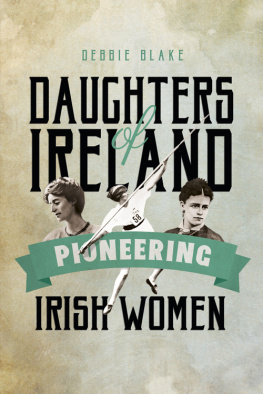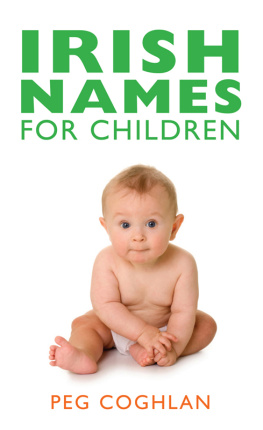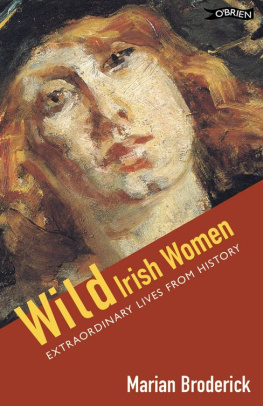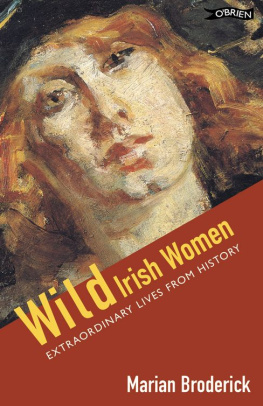
CONTENTS
It is not easy to be a pioneer but oh, it is fascinating! I would not trade one moment, even the worst moment, for all the riches in the world.
Elizabeth Blackwell
I t was whilst I was researching women in aviation that I came across the remarkable Lilian Bland from County Antrim, who was the first woman in the world to not only design, but to build and successfully fly her own aircraft, which she aptly named the Mayfly. Reading her fascinating story of sheer guts and determination led me to explore other women who had pushed and broken the boundaries of their gender to become the first in their field. I soon discovered that there were a number from Ireland, who although they were well known in their day, sadly had been long forgotten or overshadowed by their male counterparts.
Daughters of Ireland is a glimpse into the fascinating lives of a selection of some of the most innovative women in Irish history, women who were ahead of their time, paving the way for future generations to follow. They came from all walks of life, from impoverished to more affluent backgrounds, and some left their homeland and familiarity, either by necessity or choice. Whatever their circumstances they all had total commitment to their passion or cause, which they bravely followed, taking risks and facing any challenges head on. As the American businessman Alfred P. Sloan once said, There has to be this pioneer, the individual who has the courage, the ambition to overcome the obstacles that always develop when one tries to do something worthwhile, especially when it is new and different.
The lengths that the women were prepared to go in order to fulfil their goals is highly admirable. Dr James Barry (born Margaret Anne Bulkley) went to the extreme of masquerading as a man throughout her adult life in order to pursue a career as a military surgeon in the British Army. She qualified many years before women were officially recognised as medical doctors and as early as 1826 performed the worlds first recorded successful caesarean section. Nellie Cashman, intrepid pioneer of the American west, often risked her life wandering the mining camps of Arizona and Alaska during the gold rush in search of the Big Bonanza.
The women that I have chosen to include in this book each followed a different path, from Anne Jellicoe in education to Ninette de Valois in the performing arts and Eileen Gray in architecture. Whichever trail they took, these ground-breaking women provided opportunities for future generations which otherwise may not have been possible. They are truly inspirational.
1799?-1865
There was a certain effeminacy in his manner
which he was always striving to overcome.
Lord Albemarle on James Barry
T he life of Dr James Barry is surrounded by mystery and intrigue. Born Margaret Ann Bulkley, she lived the majority of her life as a masquerade, to pursue a career she loved and to succeed in a mans world. She was way ahead of her time regarding health and sanitation and her pioneering surgery and innovative medical treatments saved countless lives.
Little is known of Dr Barrys early life and as it was not mandatory to register births until later in the nineteenth century, there are several assumptions as to the details of her background and exact year of birth. Even Dr Barry herself was very noncommittal when it came to any official documentation, stating her birth date to be about 1799 although some sources approximate earlier dates of 1789 and 1795. Details of her parentage were very furtive, with speculation that she may have been illegitimate or orphaned and adopted by notable gentry. However, she did stress in correspondence to a friend that she was the nephew of the most prominent romantic artist of the eighteenth century, the infamous James Barry from Cork. It is believed that Dr Barry was one of two daughters of Jeremiah Bulkley, who ran a grocery shop at Merchants Quay, Cork city and that her mother was his wife, Mary Anne Bulkley, the sister of James Barry RA. However, Margaret always referred to and insisted that Mary Anne was her aunt.
Jeremiah Bulkley had accumulated debts which led to his bankruptcy, causing friction within the marriage, so in 1805 Mary Anne left Cork and travelled to London with Margaret in the hope of receiving help from her estranged brother, James Barry, with whom there had been no contact for many years. Unfortunately, her brother had also fallen into financial difficulty, having been dismissed from his position as Professor of Painting at the Royal Academy of Arts, and was living in hardship. However, the introduction into the circle of his closest and very influential liberal-minded friends, three in particular, was to prove imperative for Margarets future. The most influential was the romantic idealist General Francisco de Miranda, the Venezuelan revolutionary, who allowed Margaret the use of his library in which his extensive collection of books satisfied her appetite for knowledge and her interest in medicine, where she found a list of tomes to form a tolerably complete medical library for a private gentleman who is not of the profession. Her promising aptitude and absorbing mind didnt go unnoticed by the General, who saw a future for her in the medical profession, which required an education at university level. Unfortunately for Margaret she was the wrong sex, as women were not allowed admittance into university, the highest progression they could hope to obtain would be the position of a governess. It was to be around another sixty years before Elizabeth Garrett Anderson, the first female doctor in Britain, graduated in 1865. Mary Anne Bulkley was keen for Margaret to have an education and enter a profession, in order to put her in a way to get decent bread for herself but with the additional hindrance of no financial means, it remained impossible.

Dr James Barry. (Courtesy of the Wellcome Library, London)
In February 1806, James Barry RA died and although he had lived in poverty, his funeral was a grand affair at St Pauls Cathedral in London. David Stewart Erskine, 11th Earl of Buchan, had been a close friend of James Barry and was a passionate patron of the arts and had helped James financially in the latter part of his life. He was also an avid campaigner for female education, declaring that the whole female code of education must be changed. He recognised Margarets potential as a medical student, along with General Miranda and Dr Edward Fryer, the scholar and physician who had tutored Margaret. The three men became her benefactors, who worked together compiling a publication of James Barrys essays and drawings on art, in which the Gentlemans Magazine in 1806, reported that Lord Buchans intention was to publish them for the advantage of some indigent relatives of the departed artist. The Works of James Barry was published in 1809 and with the proceeds of the sale of both the book and some of James Barrys paintings, Margaret was a little closer to entering university. The prestigious Edinburgh University, notably one of the best in the world, was deemed the most appropriate choice for Margaret and with the influence of Lord Buchans aristocratic position and his connections with the university, Margaret was accepted, but only after a major decision and transformation had taken place.
It is unclear whose idea or decision it was to completely change not just Margarets name but her whole persona, but in November 1809 she became James Miranda Barry, adopting her late uncles name and the middle name of her much-admired mentor General Miranda, whom she aspired to imitate. She was to enter university life as a male, a faade that she would continue for the rest of her life. She travelled with Mary Anne to Edinburgh where they found lodgings at 6 Lothian Street, and during the three years of her studying she was prudent in her deception, leading a very discreet lifestyle. On her arrival at university James had stated that she was younger than she was, as she was conscious that her smooth complexion would not pass as a young male. She threw herself into her studies, at which she excelled, but avoided any social jovialities with the other students, keeping her friends to a minimum. Although there was one exception, fellow student John Jobson, who was a similar height to James, being around five feet, but was more athletic. He tried to encourage James to box, but found that he would never strike out, but kept his arms over his chest, to protect it from blows. John appears to have gained Jamess trust, as he was invited to her lodgings, where she referred to Mrs Bulkley as her mother, rather than her usual term of aunt. In later years John recollected James as being remarkable by the persistency with which he avoided his fellow students and remembered with amusement her long surtout or mans frock coat which she wore, comically standing out amongst the other students in their shooting-coats. He was never suspicious nor did he question Jamess gender, and was genuinely shocked when it was revealed after her death.
Next page








